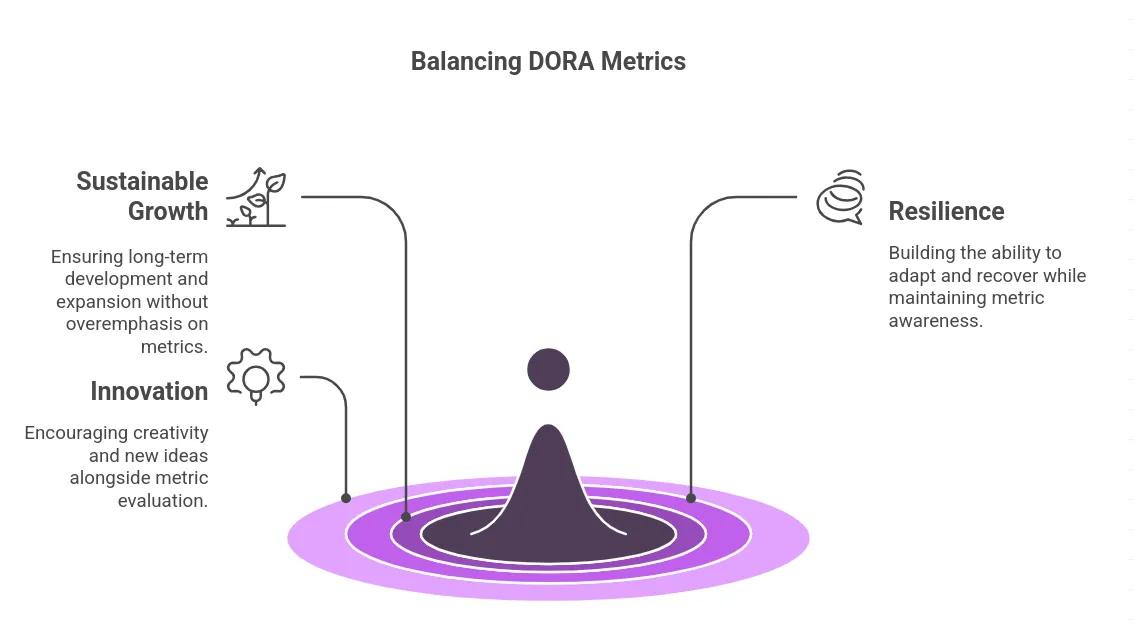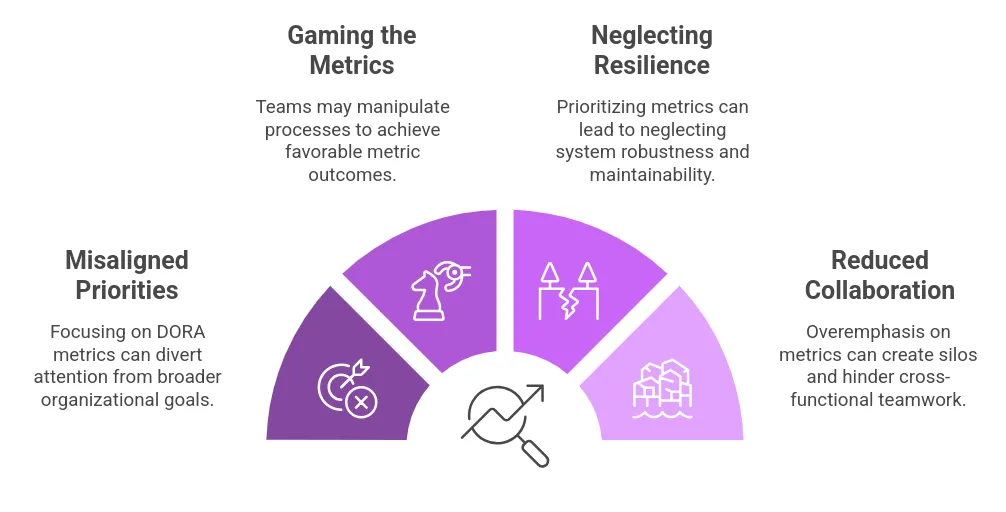January 24, 2025
Avoiding Metric Obsession: Balancing DORA Metrics with Broader Goals

By Improwised Editorial Team
Improwised Technologies Pvt. Ltd.
Avoiding Metric Obsession: Balancing DORA Metrics with Broader Goals

While they offer value in guiding teams toward efficient practices, overemphasis on these metrics can lead to unintended outcomes. Balancing DORA metrics with broader organizational objectives is crucial to fostering sustainable growth, resilience, and innovation.
The Role of DORA Metrics in Software Delivery
DORA metrics serve as indicators of performance and operational health:
-
Deployment Frequency: Measures how often code is deployed to production. High frequency reflects streamlined processes and continuous delivery pipelines.
-
Lead Time for Changes: Assesses the time elapsed from code commit to deployment. A shorter lead time indicates efficient integration and delivery practices.
-
MTTR (Mean Time to Restore): Evaluates the average time required to restore service after an incident, highlighting the effectiveness of incident response mechanisms.
-
Change Failure Rate: Quantifies the percentage of deployments that result in incidents, rollbacks, or failures. Lower rates signify reliable deployment practices.
Organizations aiming for elite performance often target improvement across all four metrics. However, excessive focus on achieving optimal values in isolation may result in counterproductive behaviors.

Pitfalls of Overemphasizing DORA Metrics
Misaligned Priorities
Focusing solely on DORA metrics can lead to optimization at the expense of broader organizational goals. For example, prioritizing deployment frequency may drive teams to release small, incremental changes without aligning them to customer needs or strategic objectives.
Gaming the Metrics
When performance is evaluated strictly through numerical metrics, teams may inadvertently manipulate processes to achieve favorable results. Examples include artificially reducing lead time by prioritizing low-effort tasks or minimizing change failure rate by avoiding risky but necessary innovations.
Neglecting Systemic Resilience
Metrics-driven decisions may result in the neglect of system resilience and long-term maintainability. For instance, prioritizing frequent deployments without investing in robust testing and monitoring mechanisms can increase the risk of undetected defects propagating into production.
Reduced Focus on Collaboration
Overemphasis on metrics can create silos within teams. Developers, testers, and operations may concentrate on their specific contributions to DORA metrics without fostering the cross-functional collaboration essential for addressing complex challenges.
Strategies for Balanced Metric Utilization
Align Metrics with Organizational Goals
Metrics should serve as tools to achieve overarching objectives rather than end goals. Aligning DORA metrics with key business outcomes—such as customer satisfaction, revenue growth, and innovation—ensures that performance improvements contribute meaningfully to organizational success.
Contextualize Metrics
Evaluate DORA metrics within the context of the organization’s unique challenges, industry, and goals. For example, a high deployment frequency may be less critical in domains where stability and compliance outweigh the need for rapid releases.
Combine Quantitative and Qualitative Insights
Quantitative metrics should be complemented by qualitative assessments of team performance, culture, and processes. Regular retrospectives, stakeholder feedback, and customer satisfaction surveys provide valuable perspectives that metrics alone cannot capture.
Avoid Metric Isolation
Consider the interplay between metrics. For instance, reducing lead time for changes should not come at the cost of a higher change failure rate. A balanced approach ensures that improvements in one area do not negatively impact others.
Invest in Foundational Capabilities
Improving DORA metrics requires robust foundational capabilities such as automated testing, continuous integration and delivery pipelines, incident management, and monitoring. These investments ensure sustainable improvements rather than short-term metric gains.
Consequences of Metric Obsession
Stifled Innovation
Excessive focus on metrics can discourage experimentation and risk-taking. Teams may avoid ambitious initiatives that carry higher chances of failure, limiting the organization’s ability to innovate and adapt to changing markets.
Short-Term Gains at the Expense of Long-Term Health
Optimizing for immediate metric improvements often overlooks long-term system health. For example, shortcuts taken to improve deployment frequency or lead time can result in technical debt that hampers scalability and resilience.
Erosion of Trust and Morale
When metrics become the sole focus, team members may feel undervalued, reducing engagement and morale. This can lead to higher turnover rates and diminished organizational effectiveness.
Loss of Strategic Focus
Organizations that overemphasize metrics risk losing sight of strategic goals. Efforts may become narrowly focused on achieving numerical targets rather than delivering meaningful customer value or achieving competitive differentiation.
Conclusion
DORA metrics provide valuable insights into software delivery performance, but an overreliance on these metrics can lead to unintended consequences. Balancing metric-driven initiatives with broader organizational objectives ensures sustainable improvements, fosters innovation, and maintains system resilience. Organizations should approach metrics as tools to guide progress rather than definitive indicators of success. By contextualizing metrics, investing in foundational capabilities, and fostering a culture of collaboration, teams can achieve meaningful outcomes that extend beyond numerical measures.

November 19, 2025
Unlocking Developer Potential: How Platform Engineering Transforms Developer Experience

By Shyam Kapdi
Improwised Technologies
Pvt. Ltd.


By Shyam Kapdi
Improwised Technologies
Pvt. Ltd.

November 14, 2025
How to Build a High-Impact Internal Developer Platform: Step-by-Step Blueprint, Tools, and Best Practices

By Shyam Kapdi
Improwised Technologies
Pvt. Ltd.
Optimize Your Cloud. Cut Costs. Accelerate Performance.
Struggling with slow deployments and rising cloud costs?
Our tailored platform engineering solutions enhance efficiency, boost speed, and reduce expenses.
